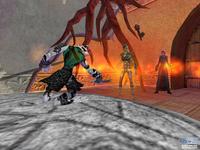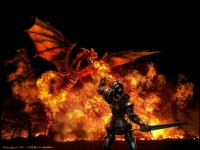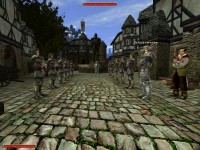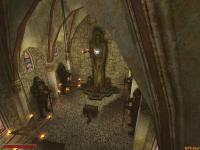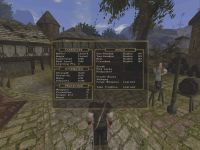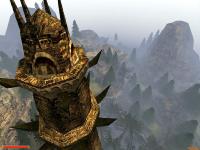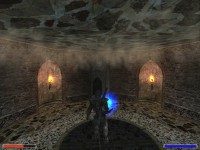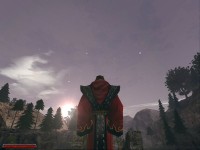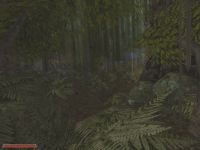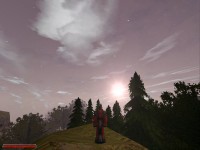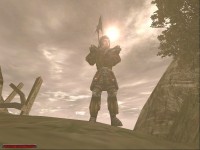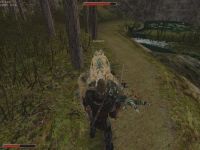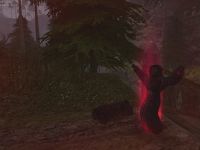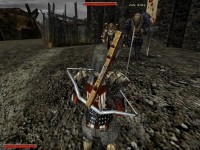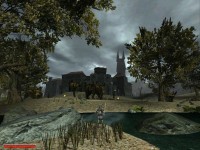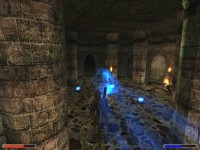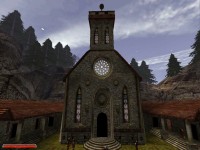|
|
|
Main News Forums Games Games Database Top 100 Release List Support Files Features Reviews Previews Interviews Editorials Diaries Misc Download Gallery Music Screenshots Videos Miscellaneous Staff Members Privacy Statement |
Gothic 2 Review
The valley of mines is packed with Orcs. In the shape of an orcdog I sneak through their lines. My tour doesnīt go unnoticed, but thankfully these powerful warriors perceive me as one of their pets. I close in on the target. My mission: "The castle is under siege. Find the Orc leader. Take him out to gain us time!". Now he is right in front of me, accompanied by a few guards. I transform back to my real shape and draw my sword. A few quick blows later he is history. Unfortunately my delight doesnīt last long. The guards surround me, there is no escape. After a short, brutal fight I hit quickload ... next time, guys, next time. The developer concentrated on classic RPG virtues. The Gothic franchise stands for story-driven single player roleplaying in a seamless 3D world. Both games are played with a single character shown from an above the sholder perspective. Combat is in real time, complicated character development has been cut back in favour of exploration of the believable game world.
Story The game takes off where Gothic ended. When the Sleeper is defeated, his temple collapses and buries the nameless hero under tons of rock. Saved from death by his magical armour, unable to move, the hero's powers diminish. Finally he is rescued by his old mentor, the necromancer Xardas, who fills him in on what happened in the meantime: After the fall of the magical barrier, freed convicts spread over the whole island of Khorinis. Suddenly safety became a major topic. Several big farmers seized this opportunity, they hired the strongest former prisoners to protect their property - against King Rhobarīs militia!
Factions You leave with food, a weapon and your first quest: obtain a magical artifact, the 'Eye of Innos'. Now youīre ready to explore the world or head directly to the city of Khorinis. A few sidequests later you have learned that Lord Hagen, the person responsible for the safety of the artifact, is residing in the upper town district. The problem: only citizens and people with special permits are allowed to enter this area. To gain access you need to join one of the three prestigious factions. Your choice determines your career throughout the whole game. Options are: (a) militia, (b) novice and (c) mercenary. Up to this point Gothic II is non-linear. You can join a faction right away and finish this part -chapter 1 of 6, to be more precise- within a few hours or you can do masses of side quests. Approximately 2/3 of the world is accessible at the very beginning. You can explore everything, talk to hundreds of NPCs and ramp up your stats. Of course many areas are guarded by fierce creatures, most of which are way too strong for a newbie character to take on. Nevertheless, you can go everywhere.
Quests The quest log is always filled with side quests. It's quite normal for your log to list ten open quests - from simple extermination missions over a drinking contest, providing safe passage for NPCs, blackmailing, assassination, collection of evidence or silently stealing something out of houses to epic tasks like killing dragons. Even the inevitable FedEx quests often come in disguise, so for me there's not much to complain about. One can always ask for more creative and less repetitive quests. The quest mix Piranha Bytes created is very enjoyable... almost during the complete game. Occasional generica arenīt really annoying, with one exception I wonīt explain due to a major spoiler. Many quests have more than one solution. Itīs also quite common that the decisions made throughout the game have consequences. Taking decision A in chapter one might cause trouble ten hours later when somebody affected by your action could refuse to do business with you or punish you in another way. Positive effects are possible, too (of course). Spending some time on stat enhancement is a good idea. Khorinis is filled with dangerous creatures, not to mention orcs and humans. Death awaits you behind every tree. Even small enemies like goblins are surprisingly lethal if given the time to surround you. Although combat is rather balanced, inexperienced players might feel a bit overwhelmed. I liked the stubborn resistance my dragon hunter had to face throughout the game. Staying alive was a challenge, but there was no need to cheat or concentrate on power-levelling. The mage and paladin careers seem to be somewhat easier, though. To sum it up, Gothic II is neither fast food nor a nail biter. A few enemies should have been harder to defeat, others a bit easier - or they should at least have been less numerous. Character development Gothic II utilizes a relatively simple character development system, supplemented by some more complex niceties. There is no character creation - you start with the same unskilled and untrained hero as in Gothic 1. You get experience points for solved quests and successful combat. When youīve collected a certain amount of experience points, you advance one level and receive 10 skill points. Each of the three factions has exclusive teachers. Independent tutors can be found in the city and at a few select locations. To be taught a skill, talk to the teacher of your choice. If you fulfil the requirements he will offer his knowledge in exchange for skill points. The most important skills and attributes (please refer to this screenshot):
Creating an über-character is discouraged by the three level weapon skill system. The road to 100% skill is separated into three levels. When two corresponding skills (one-handed and two-handed for instance) are no longer on the same level, you receive a penalty. 50% of the skill points invested in the more advanced skill are automatically spent on the less advanced until it also passes the level barrier. Magic skill is developed through gaining magic circles. Every new circle makes more powerful spells available. Mages can learn weapon skills but they are much more expensive for them. Additional skills include several flavors of hunting skills (~skinning, de-clawing...), thievery, alchemy and forging. Some abilities are guild specific. Mages can bind spells to runes, paladins can use a few runes, mercenaries can forge excellent swords.
The world The game world is split in two big parts plus an area uncovered later. Altogether they are about 2.5 times the size of Gothicīs prison colony. Each part is seamless, there are no loading breaks at all. Most time will be spent in the 'new world', the island of Khorinis. Green is the dominant color outside the populated places. Fortunately the scenery never gets boring. Far from it, some locations are ravishingly beautiful. The combination of realistic landscape and detailed vegetation cover joined with typical fantasy elements and carefully measured effects works quite nicely. Especially the magic forest leaves a lasting impression. This is a remote part of a lush, dense forest, at the end of a small path. Vivid sunbeams shine through the tree tops and highlight the medium-dense ground vegetation. A supernatural feeling increases as the stonehenge gets closer. When youīre finally there, the place is so full of magic you instantly know this location is important - even without a quest.
The world is packed with details: useful plants are hidden under trees, cemetaries are partially concealed in mist, lakes are embellished with water lilies and water effects, old battle sites are telling long forgotten stories... Different animals rove through their hunting grounds. Some have favourite prey, and knowing a particular animal prefers goblins over humans might come in handy at times. Of course hunting is an important source of income. Many different hunting skills can be learned, some more useful than others. Without them you shouldnīt expect to find much more than raw meat on a dead animal body. When you enter an animalīs field of vision/perception it will attack you - after it made a threatening gesture. This gives you a few seconds to back off. Some animals hunt in packs. The classic example is of course wolves tracking down a sheep. Later in the game a mountain path to the 'old world', the former prison colony, opens up. The valley of mines is more dangerous than ever before. Dragons and their minions destroyed it and made it their new home. Suffice it to say the contrast to the island is clearly visible.
NPCs Most of the NPCs follow a daily schedule composed from the contents of a pool of activities. They have a regular daytime job, go to the pub in the evening and sleep at night. This adds a lot to immersion and believability. Gothic 2 has an extensive news and reputation system. If you, for example, rob a merchant, you should make sure no witness can talk about your crime. As soon as Lord Andre - the local 'chief of police' - gets to know about the incident, you are in trouble. Until the matter is resolved you are considered a criminal, and honorable citizens might be rather uncooperative from now on.
The Interface The nonstandard interface was the single most criticised element in Gothic 1. Piranha Bytes addressed most problems while still sticking to their original concept. Now almost everything can be mapped to the key of your choice, to the mouse or a DirectInput device. Please check the hardware paragraph for details. Default is a shooter-like setup: (ASDW + mouse) for movement and interaction, the numbers 1 to 0 are weapon and spell slots, inventory, quest log, map and stats screen are assigned to Tab, (N or J), M and (B or C). Many simple things, for example picking up an item, activating a switch or initiating a dialog, can be done with a single mouse click. Pressing an 'action key + cursor' combination is no longer necessary. During a dialog and inside the inventory you have to navigate with the directional keys, then you can select with the mouse or Ctrl. Trading has also been simplified. You can sell an unlimited amount of items to a merchant, for gold coins. If you keep the select button pressed, the transaction speed continuously increases -this way, moving hundreds of units is unproblematic.
Combat Gothic II features two different combat systems. A refined version of Gothicīs and a new, simplified setup. Both are different in terms of aggressiveness and difficulty. The classic setup offers more strategic options ; a slow pace is recommended. Study your opponent, keep your defenses up and systematically exploit weaknesses. Pressing the left mouse button locks on a target. Now the directional keys inititate attacks and blocks. A swing to the left or right maintains your current position, as well as a block; a thrust is accompanied by a step forward. The three active moves can be combined into severalattack strings. Every single thrust and strike requires precise timing if you intend to continue a combo - mindless clicking leads nowhere. Start the next action exactly when the last one is finished. The new combat interface is pretty straightforward. Face an opponent and fight with the mouse. Left click attacks with a step ahead, right click blocks. Left/right swing and enemy-lock are mapped to the keyboard. This setup is newbie friendly, while the other system is more demanding as well as more rewarding. Replay value Gothic 2 has a relatively high replay value. Although the story doesnīt change it can be experienced from three different perspectives. Following another career path opens up a few guild specific quests and leads to a slightly modified end video. Technical stuff Required system is a P3-700, 256 MB RAM, a 32 MB graphics card and Win98 or later; recommended is a P3-1200, 512 MB and a 64 MB graphics card. The controls can be mapped to the mouse, a joystick or a gamepad. 5.1 and 7.1 surround sound are supported via Miles Sound System. The engine is an extended version of the one used in Gothic. Itīs based upon DirectX 7, DirectX 8 shaders are not used. Performance was a bit unsteady on my systems (XP 2100+/2400+, 512MB, Radeon 8500/GeForce 4 Ti 4200, WinXP Pro, resolution 1024*768*32; plus some testing on a slower machine). On the one hand I could play at maximum details in the wilderness with approximately 40 frames per second. On the other hand I had to considerably reduce the viewing distance in the city. Forunately this could be done via hotkeys.
Sound & music Gothic 2 includes 9 hours of lip synchronuous digitized speech. Every single dialog line has been spoken by professional voice actors. Unfortunately each one of them has to lend his voice to a number of NPCs, so it wonīt take long until repetitions become apparent. Occasional glitches and one miscast actor aside theyīre doing a decent job to enhance immersion into the in-game situation. The translation suffers from slips of the pen: Several texts still include German expressions, most subtitles seem to have been copied directly from the voice recording script (without bothering to remove the instructions for the actors), and to make things worse - at least once an actorīs comment on a certain dialog line can be heard. Taking into consideration the enormous amount of digitized speech the translation is still above average. Of course the QA should have caught all the issues mentioned above. I hope Piranha Bytes addresses them in a patch. Bugs and stability Both the German version (v1.28-1.30) and the UK version (v1.31) are rock stable out of the box if your PC is configured correctly. Gothic 2 is a real stress test for CPU and RAM.
Graphics As mentioned before Piranha Bytes recycled Gothicīs graphics engine and improved it a bit. Novelties are: higher polycount, more and better environment effects, smoother animations and double -sometimes even quadruple- texture resolution. Evolution not revolution, but still, the improvements are omnipresent. Gothic 2 is a typical example of a game where the result is more than the sum of the parts. Although the technical aspects - except the voice acting - have been seen in comparable or better quality in other RPGs, none of them offers such a complete set of features. They usually focus on brilliancy in one or two areas while Gothic 2 is at least good everywhere. Gothic 2 = Gothic 1.5? Is Gothic 2 more of the same? Yes and no. The new game 'feels' like the predecessor but a few important elements are different. Due to the improved interface, new combat controls and quicker spellcasting the overall gameplay experience is faster. The significantly better quest structure adds to this impression, and it leads to another big difference. Gothic was as minimalistic as can be. Everything was meant to be simple. This time a couple of elements are a bit more complicated than they appear to be. Character development for example looks pretty straight forward. Though, if you dig a little deeper you find a number of tools for finetuning, sometimes depending on the chosen career path. Gothic excels Gothic 2 only in two crucial aspects. It shows Piranha Bytes had more time refining the setting and the key characters. The Escape-from-New-York-like scenario was a brilliant idea, so one had to expect the developers to create a slightly weaker -but still powerful- setting. NPC interaction was one of Gothicīs strongest points. Mud for example was so full of life, he even had his own fan club in the German community. The NPCs you meet in Gothic 2 are a bit more routine. Only few of them stand out of the crowd, none shines as bright as Mud.
Conclusion The game is very good in what it does. It lets the player experience a fantasy story in a seamless medieval 3D world. This world is unique in its combination of details, believable NPCs and freedom of exploration. Itīs hard to find any real weaknesses except the translation: The graphics are beautiful, sound and music good, the quests diversified, story and pace pretty good. Possible points for criticism are the improved though still non-standard controls and the self-responsible real time combat. Gothic 2 takes its place among the best single player RPGs. Maybe even the top position, but thatīs a matter of taste, as always in this genre full of ambitious games. The below main rating is for the Engllish version!
Rate this title and view comments Game Info Printer Friendly Version |
|||||||||||||||||||||||||||||||||||||||||||||||||||||||||||||||||||||||||||||
|
All original content of this site is copyrighted by RPGWatch. Copying or reproducing of any part of this site is strictly prohibited. Taking anything from this site without authorisation will be considered stealing and we'll be forced to visit you and jump on your legs until you give it back. |
||




